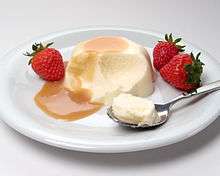Bavarian cream
Bavarian cream, crème bavaroise or simply bavarois is a dessert consisting of milk thickened with eggs and gelatin or isinglass, into which whipped cream is folded. The mixture sets up in a cold mold and is unmolded for serving.[1][2] Earlier versions, sometimes called fromage bavarois, did not include eggs.
 Bavarian cream with strawberries and caramel sauce | |
| Alternative names | Crème bavaroise, Bavarois |
|---|---|
| Type | Custard |
| Course | Dessert |
| Main ingredients | Milk, eggs, gelatin, whipped cream |
History
Bavarian cream is a classic dessert that was included in the repertoire of chef Marie-Antoine Carême, who is sometimes credited with it. It was named in the early 19th century for Bavaria or, perhaps more likely in the history of haute cuisine, for a particularly distinguished visiting Bavarian, such as a Wittelsbach.
True Bavarian creams first appeared in the United States in Boston Cooking School cookbooks, by D. A. Lincoln, 1884, and by Fannie Merritt Farmer, 1896. The Fannie Farmer Cookbook offers a "Bavarian Cream".[3]
Preparation and serving
Bavarian cream is lightened with whipped cream when on the edge of setting up and before it is molded; a true bavarian cream is usually filled into a fluted mold,[4] chilled until firm, then turned out onto a serving plate. By coating a chilled mold first with a fruit gelatin, a glazed effect can be produced. Imperfections in the unmolding are disguised with strategically placed fluted piping of whipped cream. In the United States, it is common to serve Bavarian Cream directly from the bowl it has been chilled in, similar to a French mousse. In this informal presentation, Escoffier recommended the bavarian cream be made in a "timbale or deep silver dish which is then surrounded with crushed ice".[5]
It may be served with a fruit sauce or a raspberry or apricot purée or used to fill elaborate charlottes.
Though it does not pipe smoothly because of its gelatin, it could substitute for pastry cream as a filling for doughnuts. American "Bavarian Cream doughnuts" are filled with a version of a crème pâtissière (pastry cream), not true bavarois.
See also
- List of custard desserts, mostly using eggs and not gelatine
- Panna cotta, made with gelatine but not eggs or whipped cream
Notes
- Alan Davidson, The Oxford Companion to Food, 1999 ISBN 0192115790, s.v..
- Prosper Montagné, Larousse gastronomique: the encyclopedia of food, wine & cookery, 1961. The English translation of the 1938 edition. ISBN 0517503336
- Cunningham, Marion (1990). The Fanny Farmer Cookbook (13 ed.). Bantam. pp. 961–962. ISBN 0553568817.
- The mold should be coated first on the inside with almond oil, according to Escoffier, "Le Guide Culinaire",
- Escoffier, The Complete Guide to the Art of Modern Cookery, 1903, tr. by H.L. Cracknell and R.J. Kaufmann. Reprinted (New York:John Wiley) 1999, p. 544